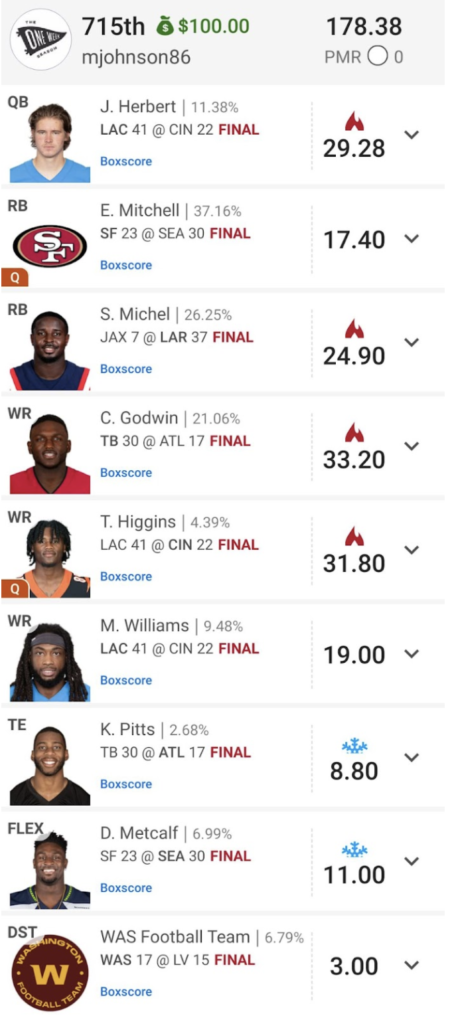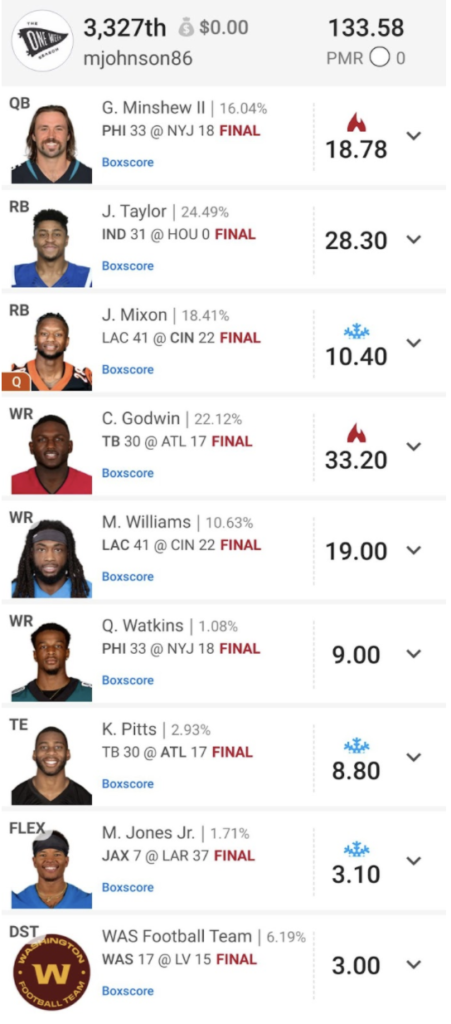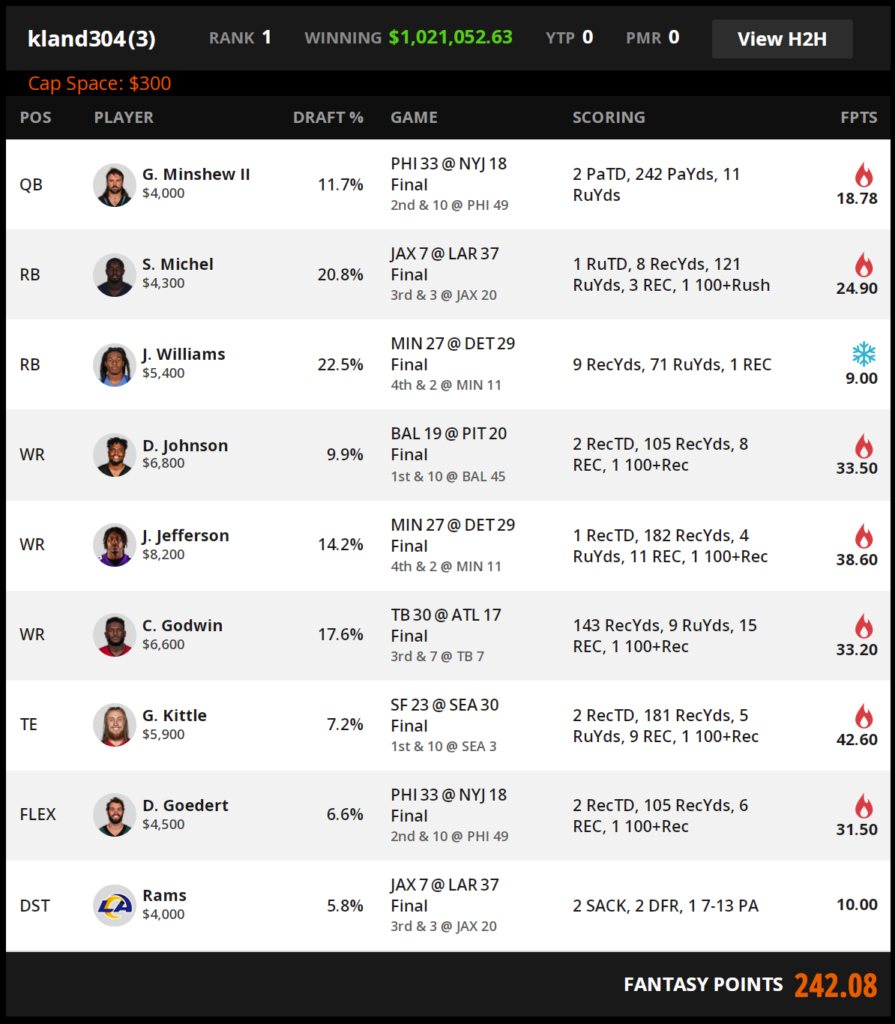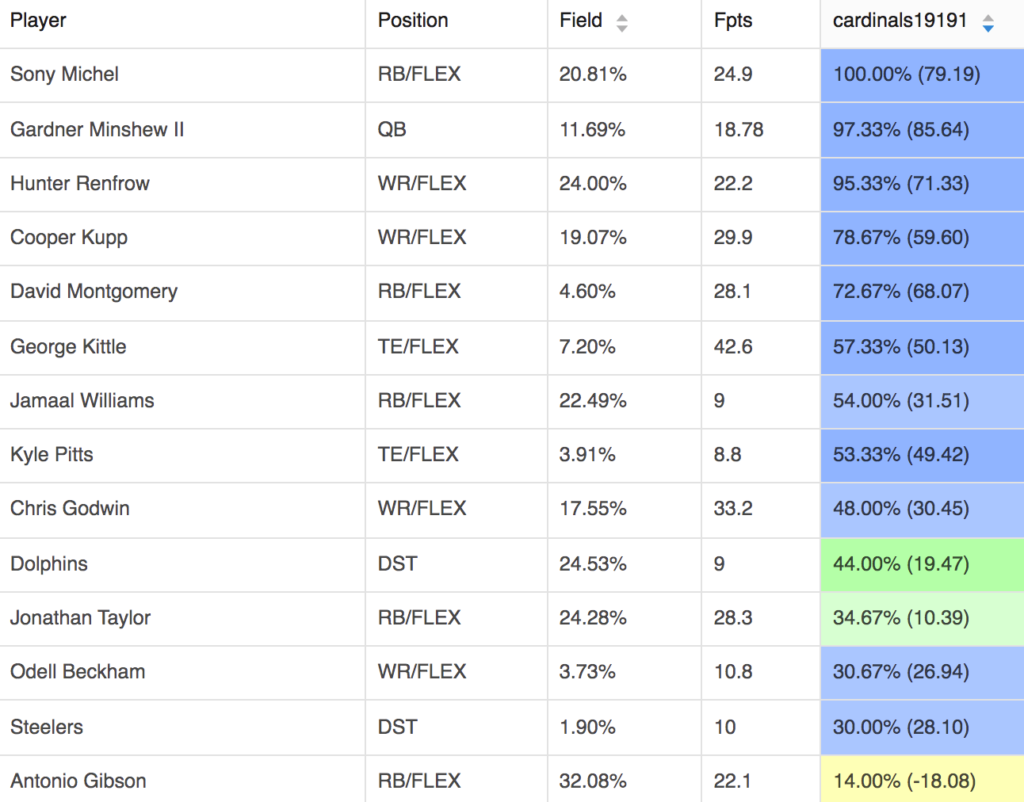Larejo123 takes a look at some of the overlooked plays and “missed opportunities” from the week behind us, identifying the thought processes and approaches that could have led us to those plays.
By the end of Week 13, it feels redundant to keep reflecting in this space to talk about where we went right, where we went wrong, and what we learned to take with us moving forward. However, we still have nearly one-third (!) of the NFL season left to go. In the regular season alone, five weeks of football await us and then onto the month+ long playoffs. So whether you’ve won or lost (chances are if you’re reading this, you’ve had some sort of sweat at some point this season), there are always lessons to be learned and foundations to keep building upon moving forward from here.
And I know this . . . DFS progress is being made. While I’m not a frequent contributor in the OWS Discord, I do frequently read the channels. And the content and discussions I’ve read over the past few weeks are lightyears ahead of discussion in the early weeks of the season. I’d be willing to bet many of you who do put in the time and effort to be thoughtful about your analysis and comments would even surprise yourselves at just how sharp the thoughts you are sharing really are. So while you may not have had a huge takedown yet, it’s coming. I feel it’s always a duty of mine here to ensure we stay positive together. To ensure we keep grinding and analyzing each and every slate, and to ensure we learn something, anything, week in and week out. Because after all, we are all choosing to be here. We’re choosing to be a part of the OWS community. We’re choosing to play a game we love, and we’re choosing to put our hard-earned money into a game of skill and luck, for the chance to financially impact our lives.
Week 13 Overview
With all that said, I don’t have any fancy theories, metaphors, or similes (I’m not sure I’ve used any similes this season, but it still applies here) this week. What I want to do instead is tackle a few leverage points which jumped off the page on Week 13’s main slate, and dictated a good chunk of the results. As always, this is how I’m seeing it and what I’m taking forward with me. This was such a fascinating slate (as many of the OWS content team talked about leading up to kickoffs) as the chalk was well-defined and obvious, and yet where you chose to differentiate became larger levers in pulling your way up or down the leaderboards. I try to take some hand-written notes during the games on Sunday, in preparation for this article, and here are my quick and dirty items to unpack with you today.
Value RBs – We Were Outflanked
It would have been one thing if we had one RB, say Jamaal Williams at $5,400, who was a clear fill-in starter who we thought (even though it turns out he wasn’t) would get a three-down role and was clearly underpriced. It would be another thing if we also got a mispriced Antonio Gibson at $5,700, in his voluminous role without his sidekick J.D. McKissic, in a great game environment as well. Let’s say we had those two underpriced backs and you were building rosters. This would have felt exactly like Week 10 when we had Mark Ingram III and D’Ernest Johnson as the clear chalk. And in that week, if you recall, we had a third option emerge in Rhamondre Stevenson, as yet another value RB, and rosters with all three backs did very well in GPPs. But flashing back to this week, we did not just have Williams and Gibson. We also had James Conner, Alexander Mattison (albeit priced up), Miles Sanders, and Elijah Mitchell, and then we were given Sony Michel before the late games kicked off. We were outflanked.
All the discussion, rightfully so, began and ended with what to do with the clear RB value this week. We heard all the strategies we could deploy. We could pick our favorite two or three of the bunch. We could play one value and one high-priced player. Heck, we could even pay up x2 at the position. But with how rare Week 13 was shaping up to be at RB, we just could not fight this transparency that was showing itself to us. When we have that many good options (I didn’t even mention David Montgomery, who should have been on our radars), it’s best to lean in. If it’s one guy, maybe two, there’s some merit to fading all or playing both or playing both plus another lookalike profiling player. It’s unlikely in this scenario that ALL of the five, six, seven backs are going to underperform, so when this happens in the future, you’ll see me embracing it and spending all my time working on other positions in planning for the week.
Top-Tier Wide Receivers
Building on this thought process of embracing the chalk at RB (embracing might be too strong a word, but you know what I mean if you just read my words), if I had focused more attention on WR this week, my rosters would have been better positioned. WR in particular was intriguing in Week 13. We had Cooper Kupp as the clear alpha of the group, and he performed like one. But as I tried to tee up with the high condensity forming among many offenses in the NFL, there weren’t that many pass-catchers we could expect significant volume from. My short-list was something like Kupp, Terry McLaurin, Chris Godwin, Mike Evans, Justin Jefferson, Adam Thielen, Keenan Allen, Diontae Johnson, Jaylen Waddle, and Brandon Aiyuk. When you looked below $4K on DraftKings, things were barren. But at this point in the season, it’s nice to see the pricing algorithms catching up to performance, and without some late-week injuries, value was scarce.
Leading up to the games, I leaned into McLaurin, Godwin, Jefferson, and Aiyuk, with some Diontae because I liked those game environment environments, and WFT, SF, and MIN all fit on my condensity tree. I’m pretty satisfied with how I tackled this position, but my error came with a few higher-priced RBs I paid for (Najee Harris, Mattison) which led me to rostering cheap WRs who did nothing (Rondale Moore, Nico Collins, Zach Pascal) and leveled out my rosters. But, while I did like my process here, going with mostly value RBs and high-priced WRs led to a very chalky roster construction, which could have been differentiated by . . .
Double Pay-Up at TE and no Foster Moreau
That’s right, as JM even teed up in some places last week, the Gronk and Kittle double-pay up at tight end would have crushed. And some did make that play. Of course, Dallas Goedert on his low volume also crushed expectations, but rosters with Kittle and Gronk would have been immediately differentiated but also kept a ceiling intact. By paying down at RB, and most likely QB and Defense, we could afford the stud WRs we wanted plus these two high-profile tight ends. This move would have been very awkward and uncomfortable to maneuver, especially with the clear chalk forming on Foster Moreau at more than half, even a third of their respective prices. But that made this play all the better.
Speaking of Mr. Moreau, I just did not get it last week. His production his entire career has been buoyed by touchdowns; as in, he has big games price considered when he scored them, and he’s off the radar when he didn’t. But for a touchdown-dependent TE, who jumps into an offense, without any weapons over a 20% share of team air yards on the season, I just did not understand why we all penciled him in for 5/50/1. I know the answer is his stone-minimum price, but if he were to be 10% owned, great then, let’s capture that safety. But as his projected ownership crept above 30% on Saturday, this play became the school of fish we look for. The chances of Moreau going for 120 yards and a touchdown were probably 5-10%, much lower than his ownership. I’m not the most contrarian player in the book, but I think I strive to never be on that play (granted I only build about five lineups a week, for MME, I would have had shares).
Sunday News with Sony Michel and A.J. Dillon
I’m proud of how I’ve handled the Sunday news the last two weeks. I’ve played both Sony and A.J. in consecutive weeks when their respective first-stringers Darrell Henderson and Aaron Jones were active and suited up to play. Why? Because their prices were solid in both cases, and in both cases with Henderson and Jones, there was enough reporter and beat writer speculation about them seeing a limited snap count and being used primarily as decoys.
In Sony’s case, his price was so cheap at only $4,300, and the news came from FOX’s Jay Glazer who usually is trust-worthy, that I started to lock him in where I could prior to the Rams kickoff, and it still wasn’t enough. But with the positive game script they were expected to have, and the Rams lack of depth behind Sony, he made too much sense. It felt uncomfortable with Henderson being active, but active in case of emergency only at this point. Last week with Dillon, we thought he would be the featured back all week, then when Jones surprised us by suiting up, we knew Dillon’s talent was there, and it became a question of whether he could still hit value, which he did.
Either way, get in the breaking news channel in OWS Discord. Read JM’s 11:30 am EST Angles email. React on Sunday to what you are seeing and hearing even through the early games. Your bankroll will thank you.





